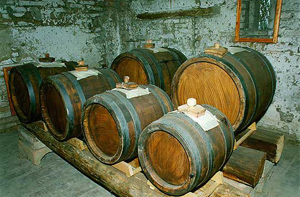|
||
How Vinegar Is MadeVinegar is the end-product of a chemical reaction that occurs when bacteria (Acetobacter aceti) come into contact with alcohol. The bacteria turn the alcohol to to acetic acid and water. It is the alcohol turned acidic which provides vinegar’s unique taste. While acetic acid provides the vinegar with its primary taste component, it is the nature of the actual alcohol itself that gives the vinegar its specific character. Vinegar can be produced or generated in a number of different ways. It can take months with a hit-or-miss outcome; so by 2000 B.C.E., much vinegar was produced commercially by vinegar “masters.” Even so, success was not guaranteed. It was not until medieval times in Orléans, France, that a method was perfected, still used today for low-volume, high-quality batches.
|
 Balsamic vinegar production at Villa Gaidello, a working farm organic farm in Italy’s Po River Valley between Modena and Bologna. It has a restaurant and restaurant and guest rooms, for individual travelers or corporate meetings. |
|
|
The Classic Orléans Method *The “mother” is a film of living bacteria on the surface of the liquid being soured. Mother can also grow in bottles of vinegar at home, especially those that have been sitting for a long time in a warm, dark environment. While unattractive, mother is harmless and believed to be beneficial to digestion. Refrigerating vinegar will slow or stop the formation of the mother. You can decant vinegar into another bottle, clean the bottle with the mother, and pour the vinegar back in. Modern Vinegar Production The Astringency Of Vinegar
It is important to note that the quality of the ingredients, processing style, aging and bottling will affect the ultimate taste of the vinegar; so the tartness ranking is relative. Over time, my desire for such a sensation has been sated, and it is the more artfully produced product that moves me and my somewhat more discriminating taste buds. Balsamic has unsentimentally replaced red wine vinegar in most of my dressings and marinades. I do throw some high-quality red into the mix on occasion, for old time’s sake. That vinegar is still such an essential ingredient after so many millennia is a tribute to its taste and versatility. Perhaps “she” needn’t lie about her age after all. Continue To Page 3: Types Of Vinegar ~ A To C |
||
Last Updated May 2021
© Copyright 2005-2025 Lifestyle Direct, Inc. All rights reserved. All images are copyrighted to their respective owners.